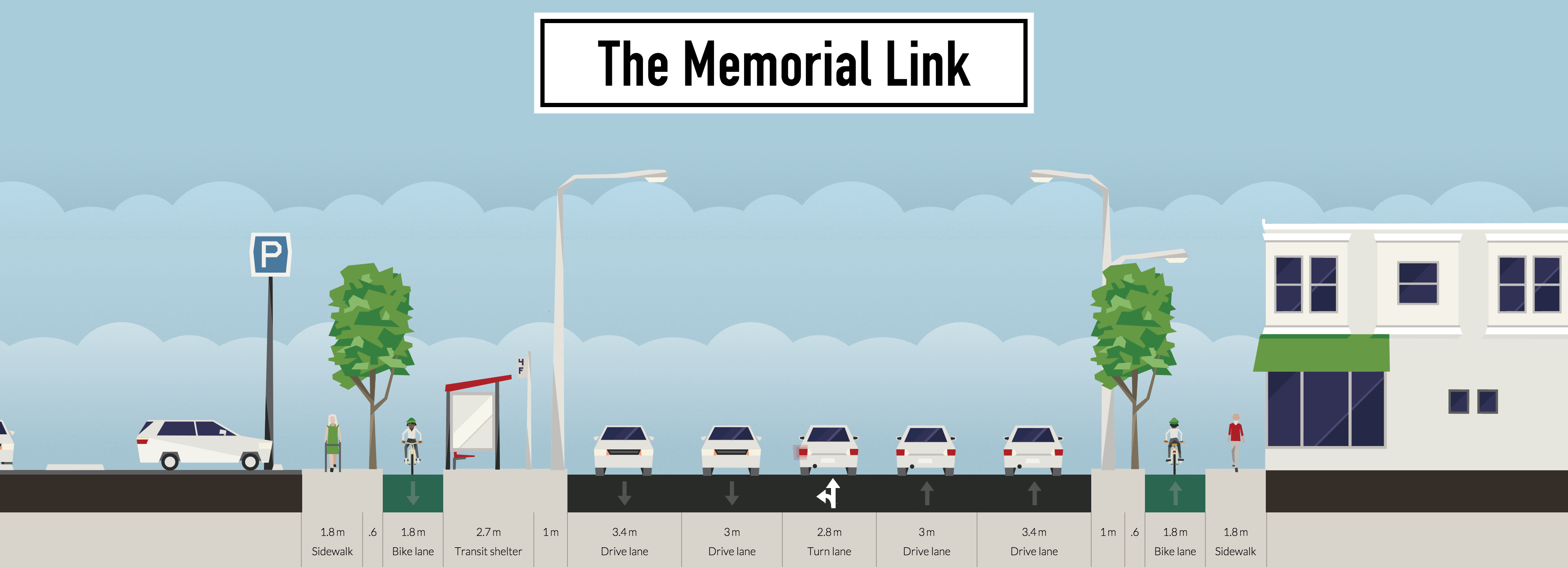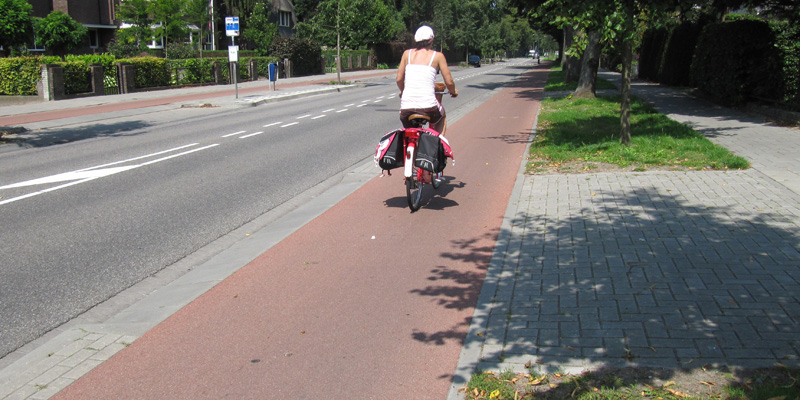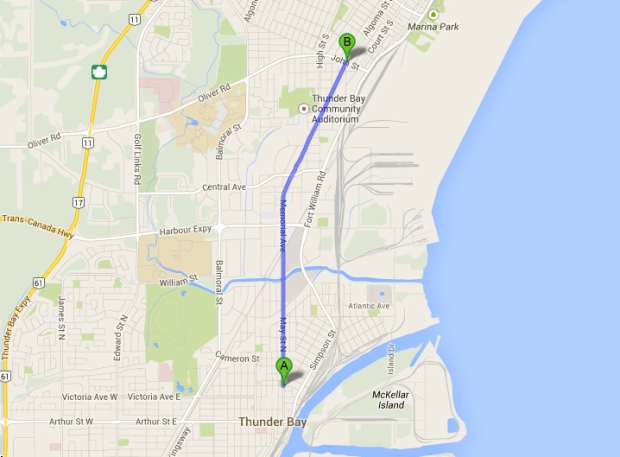The Memorial Link

It’s hard to believe that the last time I wrote about bike lanes was almost 3 years ago. At that time I highlighted the major deficiency in the way we support cycling in Thunder Bay — specifically the lack of protection from cars. I went on to endorse what I called “the missing link” which were a series of cycle corridors (a grid) along busy streets in Thunder Bay to allow people to quickly transit the city on two wheels. A lot has happened in those 3 years. For one, some friends and I fully baked my proposal into a movement to create Thunder Bay’s first real cycle track called The Memorial Link. First we ran a petition. We went to council and gave a deputation, presenting photos, educating councillors about bicycle separation and asking for three specific things: that council add the May-Memorial corridor to the Active Transportation Plan, request that administration study cycle tracks in upcoming Transportation Master Plan, and direct administration to develop a complete streets policy as a part of the same plan. We even explained it in a way people could understand— The Memorial Link will get bicycles off the road. We got some national coverage by the cycling community which is nice but our target audience wasn’t and isn’t cyclists. It’s everyone.
Some items in that list of requests to council are in the process of being done. The City’s Terms of Reference for the upcoming Transportation Master Plan include studying North/South cycling corridors (page 20) and language in the same document mentions development of a complete streets framework or policy. There’s no discussion about cycle tracks which are proven to induce demand for cycling and the city has built infrastructure since that, for barely more money, could’ve been a cycle track (Vickers St is an easy example).
Prior to our deputation we secured almost 1200 signatures in an online petition and certified almost 900 signatures with the city clerk in a pen-and-paper petition (required by the city to be officially recognized). These signatures were presented to council. After that deputation we didn’t sit on our hands either. We contacted the Lakehead University Engineering Department and arranged to have a study done of the feasibility of the Memorial Link by a team of fourth-year students. Their completed study basically said “yes, we can do it”. But don’t take my word for it, read it yourself. We spoke with the Thunder Bay Chamber of Commerce and got an endorsement for The Memorial Link because the business community understands that accessibility by bicycle makes economic sense. We’ve actively worked to become stakeholders in the consultation process for the Transportation Master Plan. We’ve appeared many times in the media working to educate the public about our proposal and are participating in more discussions than just bikes. Finally on December 5 city council will hear from the Engineering division that there is no technical reason that the Memorial Link can’t be built. Specifically the memorandum states that “a generous amount of space is available to implement this type of facility” and that “with the proper planning, design and education, none of [the issues mentioned in the report] are insurmountable”. Incidentally the issues mentioned in the report (like driveways) all have straightforward engineering solutions.

It’s just political will and money standing between us and a safer more livable Thunder Bay, the latter of which is either available now or about to be available from other levels of government specifically for projects like this. Of course without a shovel-ready design we’re unable to take advantage of that money.
Unfortunately this report will also punt the Memorial Link to the Transportation Master Plan process. Here’s the thing— it’s not our proposal anymore. Every day people I’ve never met talk to me about The Memorial Link. It has taken on its own life. It’s the only proposed cycle corridor with a public conversation around it and signatures of supporters, not to mention statements of support. It’s the only corridor with endorsements. It’s the only corridor that passes businesses. It’s the shortest route between the downtown cores. And there are No. Insurmountable. Issues.
What is the Memorial Link?
The Memorial Link is a proposed 5 km physically protected lane for bicycles and active transportation along Memorial Ave through the heart of Thunder Bay. It would start at Paterson Park (the corner of May St and Miles St) in the south core and run along May St and Memorial Ave all the way to John St at Algoma.

On both ends roads are narrow enough and traffic low enough that it’s already quite safe and comfortable for average people to bike, but between those two locations traffic volumes and speeds are treacherous despite the fact that the connection between both locations is a convenient, flat, and straight line. The key feature of the Memorial Link is physical separation on the busy parts. While some parts of the path can be buffered bike lanes (double pained edge-lines with green markings at intersections and conflict points for example along May St south of Northern Ave) at least 3.5km of the route should have bicycles up on the boulevard in a dedicated space that cars cannot physically enter. The bikeway would have a consistent grade and colour through driveways to clearly identify right-of-way. Intersections would, over time, be reconfigured to allow safe riding through them. Construction could be incremental as has been done in many Canadian cities like Ottawa, Vancouver, Calgary, Victoria, Winnipeg, and now Edmonton. Even car-mecca Los Angeles is retrofitting cycle tracks on to busy streets.
Why build the Memorial Link
People bike on Memorial Avenue right now. This may seem crazy if you don’t do it (because it is) but that won’t stop it from happening. People need to get places and they take the fastest / simplest route possible.
[gallery ids=”605,594,592,590” type=”slideshow”]
It seems crazy to me that in 2016 I have to explain to people why we need good bike infrastructure but I’ll humour everyone and do it again. Here are some highlights.
We need to get bikes off the road. Drivers can be distracted or careless, sure, but this isn’t the heart of the issue. They’re operating multi-ton metal projectiles right next to children biking to school. This is insane. But we’ve also built the urban environment to make us drive everywhere. Cars need to be tamed. We’ve given them every last bloody inch of space in our city. Want to know why people don’t walk or bike? It’s because we’ve made it unsafe and uncomfortable. Getting bikes off the road makes the results of driver inattentiveness less harmful. It also makes biking more comfortable.
Right now anybody without a driver’s license pays for their transportation with time. Transit headways are 30 minutes meaning there’s an immediate tax of 30 minutes on every trip. Children can’t cross town with their parents on a bike. Seniors can’t get around without a car. People too poor to drive can’t get around. People wealthy enough to drive don’t have a choice.
A great argument in favour of the Memorial Link is the personal finance argument. The CAA says the average cost of owning and operating a compact car in Canada is $9000/yr. Experts say 85% of the cost of a car leaves the local economy. That means every car in Thunder Bay causes, on average, at least $7650/yr to leave the local economy. For an average household with 1.5 cars that’s almost $11500/yr. If we could reduce car ownership by only 5% that would represent at least $23M/yr of additional money in the local economy. You’re not going to reduce car ownership unless people have options. The data bears this out. Several studies have shown that people on bikes spend more money per month shopping than people driving cars.
There are other great reasons to get us biking too like the fact that Thunder Bayers are more obese than the average Canadian.
How much will it cost
For starters curbs cost about $200 per metre in Thunder Bay according to the engineering division. So if we were to just rebuild every curb on the 3.5 km stretch from Northern to Algoma that would run $1.4M. On top of that would be the cost of repaving the asphalt on both sides of the reconstructed curb which could run another $1.5-2.0M. Re-striping would be another cost. Non-beaded thermoplastic costs $3.50/m installed on the high end, or $20/m for a 5-lane road with buffered paint lanes. Only part of the route would include painted lanes (the May segment) so it’s fair to say the cost of additional markings would be “free” in this calculation. That works out to $100,000 in markings. We’ll be generous and say $250k. So now at the high end we’re at $3.75M to cycle track 70% and buffer 30% of the route to completion. There are other considerations, specifically intersection and driveway treatments. There could plausibly be another 1000 m of curb reconstruction at driveways and intersections to maintain a constant grade. Further thermoplastic treatment for visibility at intersections and driveways has a high installation cost. It’s fair to say an additional $500k could be required bringing us to a high-water mark of $4.25M. And that’s assuming we’re willing to eat into the existing road-bed. Otherwise we need to budget for moving utilities on the boulevard in some areas which could add another $1M to $2M bringing us to a high mark of $6.25M and potentially much less. The thing is I haven’t even considered the fact that there are lots of places along the route where the proper infrastructure is essentially already built. There are very wide paved boulevards on at least 1 km of each side of the street already where a simple resurfacing and stripe job is all that is needed. This saves more than $500k in curbing and paint. So it’s safe to say using the above numbers that we can build a very good implementation of the Memorial Link for under $6M. Please consider that the city has already spent $4M on studying the Events Centre. Or that the recent reconstruction of Balmoral St (phase 1) had an engineering flaw in the design (drainage) that resulted in a $2.7M cost overrun. Six million dollars for a piece of transportation infrastructure 5km long is peanuts compared to many of the things we spend money on. Bike infrastructure is cheap. But we can build it for way cheaper if we’re willing to do what Montreal does and build buffered lanes with bollards. There are many paths forward.
Here’s the thing though. We don’t have to guess how much it will cost because we’re not the first ones to do this. Calgary decided to pilot a 5.5km bike network in 2014. This is about 10% longer than the Memorial Link proposal. They budgeted $7.1M. They completed it for $1.35M under budget at $5.75M. Downtown bike traffic increased 70% and by almost all metrics it’s exceeding expectations. Next year Edmonton will be piloting a 7.1 km cycle track network downtown. They’re projecting a cost of $7.5M. Victoria is going to build 5.4 km of cycle track for completion in 2018. It’s not being done as a pilot with flexible bollards so the cost is higher, more in-line with my estimations above. But it’s still only $7.75M, just slightly higher per km than my estimation.
That’s just 3 examples. Thousands of cities have built cycle tracks to get bikes off of the road and make biking a real transportation option and the costs have been very reasonable. And I’m not even going into the socio-economic benefits here, just construction costs.
It’s only the first step
Oliver Road, Central Avenue, The Harbour Expressway, The Waterfront trail (currently at least 10 years away), enhancements to Beverly St, these are all safe protected bike routes that are needed. What normal people really need to be able to ride bikes is to not have to pre-plan a route in fear before they consider getting on a bike. The Memorial Link is ground zero. It’s step one in a minimum grid of safe accessible bike routes designed not for spandex-wearing middle-aged men training for a race but for average humans doing average things. The exact people who don’t ride right now because they’re afraid and don’t have extra time to become “cyclists” are the ones who will benefit from this.